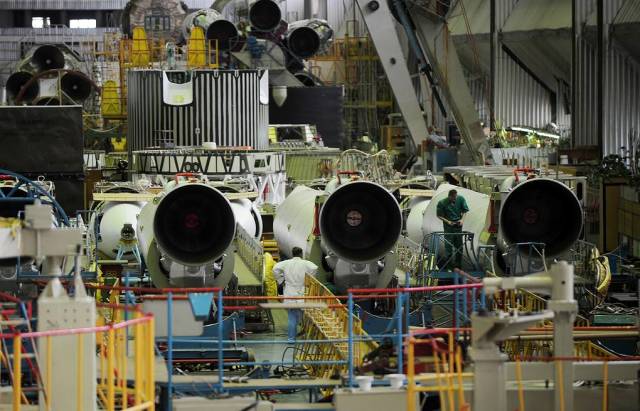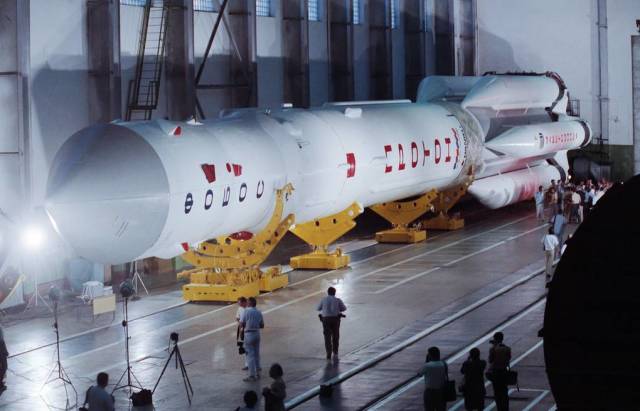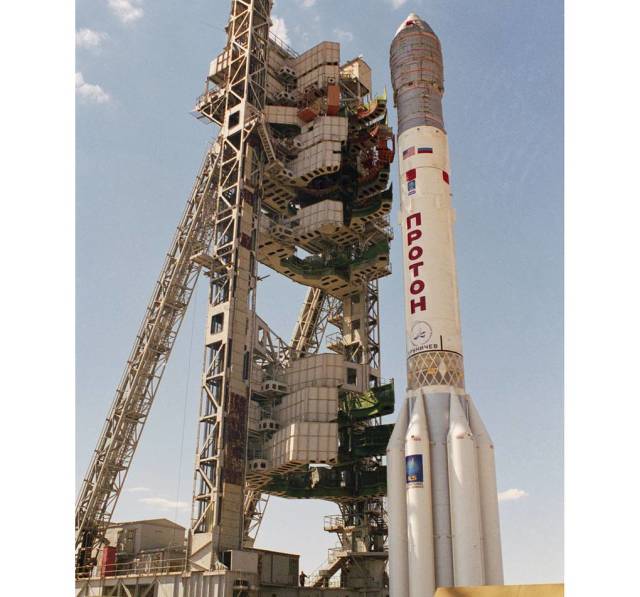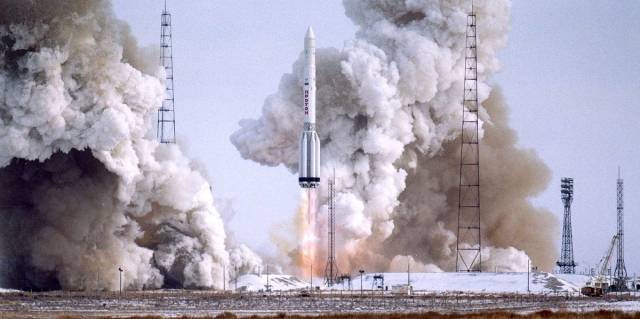55 years ago, on March 10, 1967, a three-stage Proton-K heavy class launch vehicle was launched for the first time from the Baikonur cosmodrome. During its more than half a century-long career, Proton has launched into space all stations of the Salyut and Almaz series, modules of the Mir and ISS stations, many heavy communications satellites, as well as scientific and defense devices. About how the space heavy truck was created - in the material of TASS
Born in a race
In the early 1960s, at the height of the Cold War, the designers of the USSR and the United States were actively working on the creation of new universal missiles that could put the maximum payload into orbit, and in the event of a nuclear war, hit the enemy with a super-powerful nuclear charge.
There was a space race of its own inside the Soviet Union. Leading design bureaus fought for the right to create the first heavy rocket, including Sergei Korolev's OKB-1, Mikhail Yangel's OKB and OKB-56 under the leadership of Vladimir Chelomey, whose ideas later formed the basis for the creation of Proton.
To solve the task set by the Soviet government, Chelomey proposed a project called UR - "Universal Rocket". The idea was to create a family of four carriers that would immediately cover all the needs of the country both in defense and in space exploration. Thus, the UR-100 and UR-200 could be used as intercontinental ballistic missiles, the UR-500 for launching heavy spacecraft into orbit, and the UR-700 for flights under the Soviet lunar program.
Nikolai Bodrikhin, writer, space and aviation historian
Sergey Korolev's team, in turn, insisted on the need to use its "nine" (R-9) as a ballistic missile and the N-1 as a promising lunar carrier. As a result, the N-1, largely due to the indisputable authority of the Queen, was recognized as the most successful version of a heavy rocket. Assembly shops and a launch pad at the Baikonur Cosmodrome began to be built for her. But it was not possible to carry out the plans of the Queen. In 1966, the famous designer died suddenly, and all four launches of the N-1 ended in failures, which soon led to the closure of the project.
Universal five hundred
One of the main advantages of Vladimir Chelomey's project was that the missiles of the UR family were largely unified among themselves. At the initial stage of the development of the five hundred, as the UR-500 was called by Chelomey's associates, it was supposed to create a bundle of four UR-200 missiles, which was supposed to facilitate production and speed up the technological process. However, analysis and experiments on the layout revealed the imperfection of such a scheme. As a result, the Chelomey team decided to use a two-stage version with a tandem arrangement of steps.

Assembly of the Proton-M launch vehicle in the workshop of the Khrunichev State Space Research and Production Center
Image source: © Vladimir Astapkovich/TASS
The first stage of the UR-500 had to be developed from scratch. The second was a modified version of the first stage of the UR-200 rocket. In Khimki, near Moscow, engineers of Academician Valentin Glushko Design Bureau (now NPO Energomash JSC) created the most powerful engine with a thrust of 150 tons at that time for the first version of the space heavy truck.
A combination of asymmetric dimethylhydrazine and nitrogen tetroxide was used as fuel for the UR-500. "Both elements were extremely toxic, but they had the necessary characteristics and high energy efficiency at that time. They didn't think about ecology at that moment, it was much more important to create a rocket as soon as possible. The design and creation of the UR-500 was carried out in almost unattainable terms by today's standards. The rocket was fully developed in less than three years by several research institutes at once," notes scientific journalist Mikhail Kotov.

The UR-500 Proton launch vehicle
Image source: © Albert Pushkarev/TASS
According to Chelomey's idea, in the future the UR-500 was to fully justify its name and put into orbit the widest range of spacecraft for solving defense, research and national economic tasks. On the UR-500, the designer planned to put into orbit his first manned rocket plane, a variant of the space shuttle, which work continued until the 1980s and was stopped due to the appearance of a similar, but larger-scale project Energia - Buran.
First launch
According to historians of Russian cosmonautics, the UR-500 project took place largely thanks to the support of Nikita Khrushchev. The Secretary General, under whom the nuclear shield of our country began to be created, liked a large rocket that could simultaneously fly into space and, if anything, quickly get to the territory of a potential enemy with a nuclear charge on board. The only remark Khrushchev made in the early 1960s, when he was shown a huge mock-up of the launch shaft. He turned to Chelomey with a question: "So what are we going to build - communism or mines for the UR-500?" Later, in his memoirs, Khrushchev spoke with admiration about the military and space offspring of Chelomey.
from Nikita Khrushchev's book "Memories",
No less grandiose was the ground infrastructure for the new heavy rocket at Baikonur, where its first launch with the Proton-1 satellite took place on July 16, 1965. At that time, the UR-500 did not yet have a name, but Soviet TV and radio announcers called it the same as Sputnik. So the name "Proton" was fixed for the UR-500.
Later, in the 1970s, a unique launch pad was created for Proton. Soviet engineers invented a design that made it possible to fix the tail of the rocket on the table supports, which provided maximum stabilization during the preparation and conduct of the launch.
"Proton-K"
Shortly after the launch of the first version of the Proton, the development of a new modification of the Proton-K rocket began. According to Roscosmos, the rocket was developed on the basis of the UR-500 with some changes in the second stage and with the addition of the third and fourth stages. This made it possible to increase the payload mass in low Earth orbit, as well as to launch spacecraft into higher orbits.
The launch weight of the rocket was 695 tons, the payload mass put into orbit 200 km was 21.5 tons, the length of the rocket without the head was 42.34 m.

Proton-K launch vehicle
Image source: © Sergey Kazak/TASS
Proton-K also received an autonomous inertial control system, which ensured high accuracy of launching the payload into various orbits. The control system was designed by designer Nikolai Pilyugin and used gyroscopes, the development of which began earlier on Sergei Korolev's R-5 and R-7 rockets.
The first Proton-K with an upper stage D and a mock-up of the Kosmos-146 spacecraft was launched on March 10, 1967. The launch vehicle flight test program was completed on September 29, 1977 with the launch of the Salyut-6 orbital station, which stayed in orbit for 1,764 days, made 27,785 orbits around the Earth, took five main expeditions and ten visiting expeditions (more than 35 cosmonauts from ten countries of the world). On June 27, 1978, the rocket and space complex with the UR-500K carrier rocket was accepted by its customer, the Ministry of Defense.
With the help of Proton, which later became the most massive heavy carrier in the USSR, automatic lunar stations Luna-15, Luna-16 and Luna-24, interplanetary stations Mars-4 and Mars-7, Venus-9 and Venus-10, long-term orbital stations Salyut, manned stations Almaz, base modules Mira and ISS, geostationary spacecraft Raduga and Ekran, as well as ships were launched into space supplies for our astronauts in orbit.
Since 2001, at the Mikhail Khrunichev State Space Research and Production Center (part of the Roscosmos State Corporation) A more modern modification of the Proton-M rocket is being produced. The new version is characterized by increased environmental friendliness, a digital control system and a new Briz-M upper stage, which made it possible to significantly increase the payload when launching into geostationary and geostationary orbits.
One of the most significant recent events for the world cosmonautics, which took place thanks to the Russian heavy rocket, was the launch of the multipurpose laboratory module "Science". It will significantly expand the program of scientific experiments of the Russian segment of the ISS.
According to the Director General of the State Space Research and Production Center named after M.V. Khrunichev Alexey Brewhenko, by 2023, the production of the last four Proton-M launch vehicles should be completed in the Moscow workshops of the enterprise. "The personnel involved in this is already smoothly reorienting to the production of the third stage of the Angara-A5 rocket," he added. It is expected that the new heavy launch vehicle will be able to launch up to 37.5 tons of payload into space.
Vasily Kuchushev
The article uses materials from Nikolai Bodrikhin's book "Chelomey"

